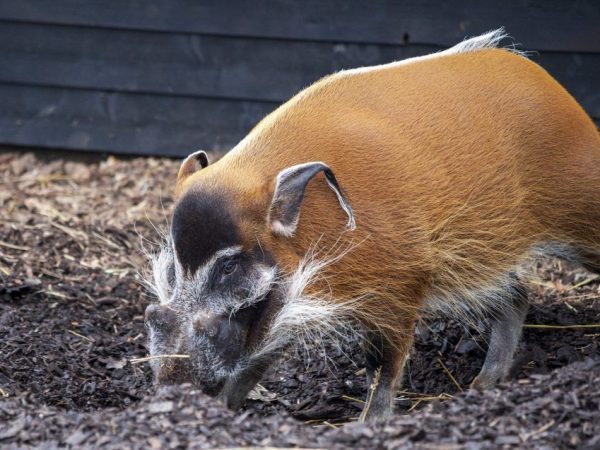Brush-eared pig, characteristics and description of the breed
The bristle-eared pig has several important differences from its counterparts. This can be seen in her appearance, behavior and lifestyle. To survive in the wild, the pig has to show its strength, agility and quick action. The bristle-eared pig got its name from the elongated hair that grows on the cheeks.

Bristle pig
Representatives of this breed live in some parts of Africa. They do not like dry places, they prefer to live near water bodies. Entire families can be found in the tropics.
Origin
Several decades ago, African and Madagascar pig breeds were considered one species. But experts conducted a comparative analysis and identified some external similarities.
After a long study and research by specialists, it was decided to separate them. Shrub individuals have a less bright color, and River ones are smaller in size. Differences in appearance can be clearly seen in the photo on the Internet.
Appearance
The bristle-eared pig has a dark red shade of color and a characteristic strip of light color that stretches along the entire body. The tail of such pigs is thin, mobile and long (almost 45 cm). There is a black and white brush at the tip.
Distinctive features of piglets are as follows: the ears are long and slightly pointed, there are white or black tassels on the sides. Pigs are distinguished by the color of the brushes. At the sight of fellow pigs arch their back and tilt their head, their ears change their position.
The head has a black color, it resembles an oval in shape, there is a hump on the nose. The piglet is small in size, the sideburns are elongated. White edging can be seen around the eyes. Fangs and tusks are sharp, so these animals can easily hunt in the wild. To distinguish a female from a male, it is necessary to pay attention to the bony tubercles, which resemble horns bent in the other direction. They are located between the ears and eyes. The bristled male is larger in size compared to the female, its muzzle is more elongated.
African pigs have sharp fangs, with the help of which they can easily gnaw through absolutely any object. The pigs can weigh up to 100 kg, but the body looks proportional. It is muscular and elongated, the shoulders are powerful, the legs are short and slender. The average length of the body is 120-160 cm. In bristle-eared pigs there is no hanging belly.
African pigs are agile, agile and fast. They pick up speed very quickly while running to survive in the wild. This kind of pigs can even compete with hunting dogs. But, unlike dogs, pigs quickly get tired and inferior in endurance.
What do they eat
Brush-eared pigs are unpretentious in food. Their main diet is plant and animal foods. The daily menu includes the following products:
- various roots;
- ripe fruits;
- Strawberry;
- invertebrates.
At night, pigs often come to their summer cottages, which are sown with various crops. Pigs can feast on cloven-hoofed animals, as well as destroy the entire future crop at one time.Local residents do not like them, so they are often caught and exterminated.
Lifestyle
To find food for themselves, Bristle-eared pigs are predominantly nocturnal. This is their hallmark. During the day they can be found in earthen burrows, which are carefully camouflaged from predators. This breed of pigs lives in whole herds, which are headed by a mature and strong male. The total number of individuals in a herd can reach up to 17-20 pigs. This number includes females and offspring.
The duration of the sow's pregnancy is 120 days. In one farrowing, the female brings up to 5 piglets. The cubs are equipped with a nest, which in its shape resembles a round haystack. Small pigs are constantly monitored by adults. The period of feeding with milk is 3-4 months. They gradually become accustomed to adult solid food. After 3 years of age, puberty pigs reach puberty.
Family groups clearly fence off their own territory. It is marked with a secreted secret or scratches in the trees. Individuals gnaw them with their sharp fangs. If the family is attacked by predators, then the pigs flee. In an imminent collision with the enemy, they begin an attack. Many animals do not dare to attack the family, being wary of the impressive size. In most cases, hyenas and other predators of the feline family become enemies of this type of pig.
Such pigs do not like hunting dogs, therefore, if they come into sight, the herd starts an attack. Most often, pigs kill them and divide the prey.
Bristle-eared pigs are intelligent and have a keen sense of smell. Poisoned baits do not produce the desired results.
These animals only in isolated cases can become pets. Such situations have been seen in eastern Africa, where people create special conditions for this.
Conclusion
Bristle-eared pigs first appeared in Central and West Africa. They do not settle in arid regions where open water bodies are absent. They are unpretentious in food, they feed mainly on plant and animal food.
They differ from their counterparts in a remarkable color, long tail, peculiar tassels on the ears. It is their unusual appearance that they attract the attention of people. In special situations, pigs can show aggression, attack enemies, join the attack and destroy them.


